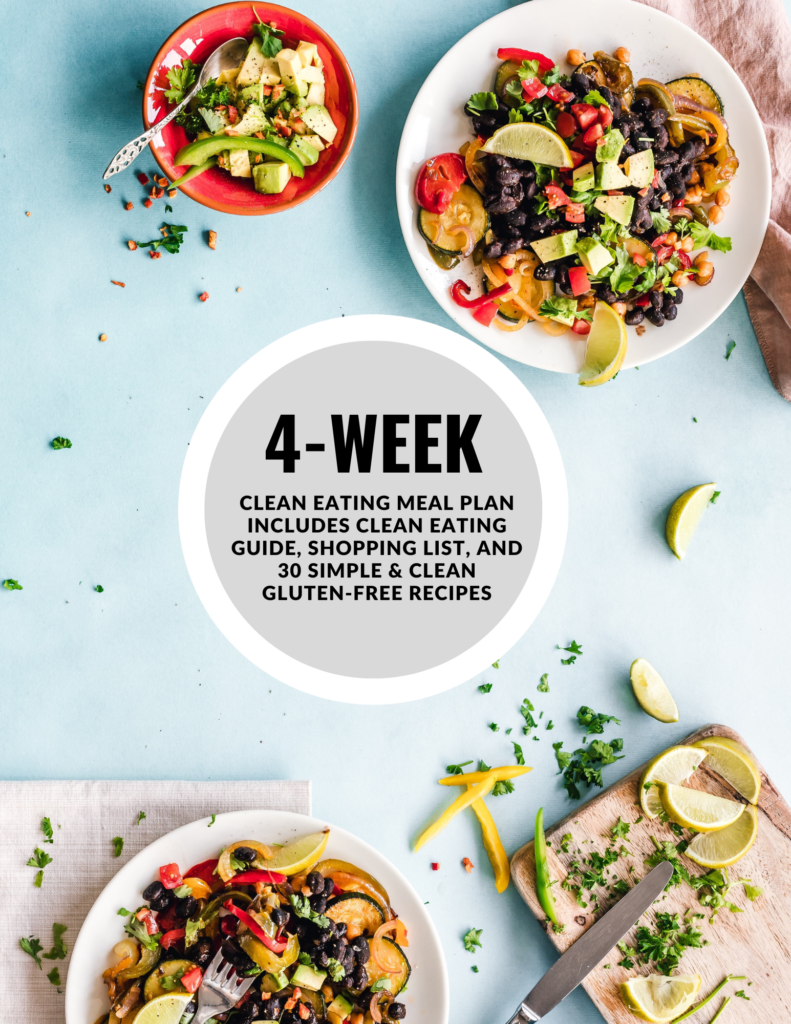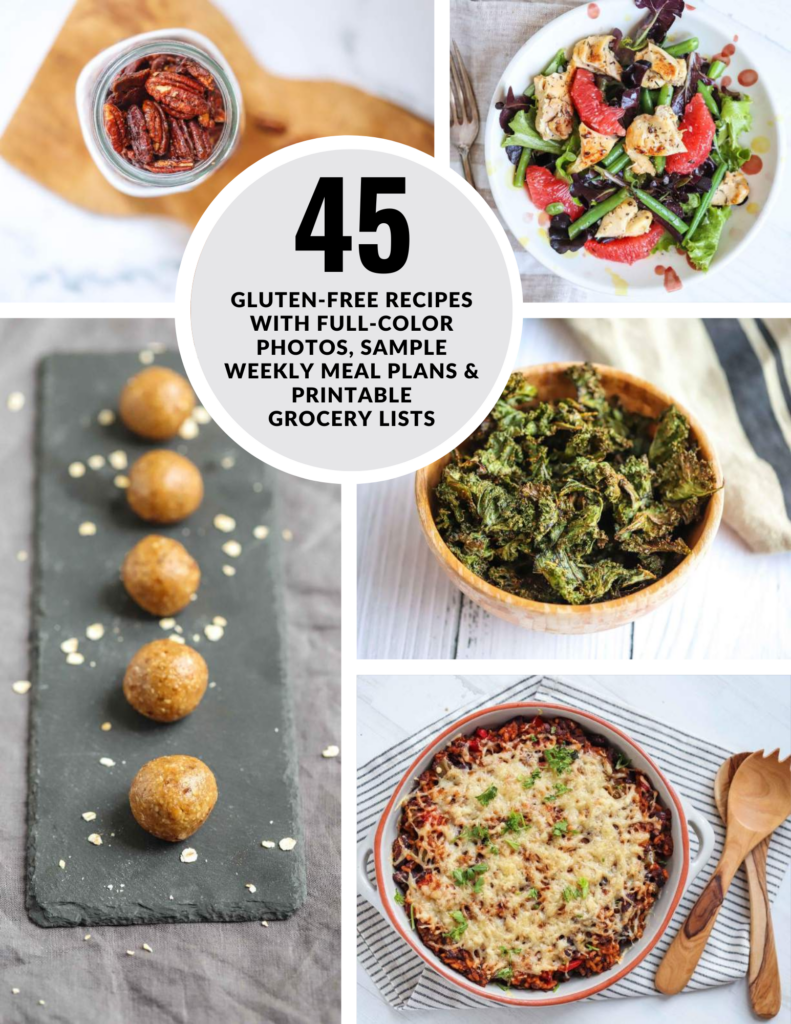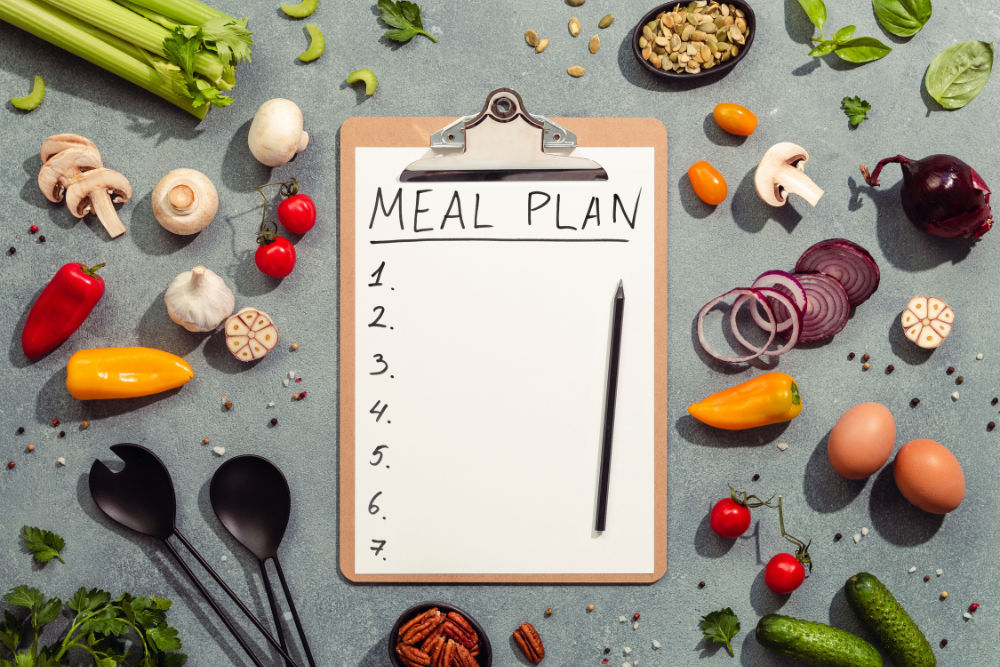
Are you following a gluten-free diet and struggling to plan your meals? Whether you have celiac disease, gluten sensitivity, or simply prefer to avoid gluten, meal planning can be a challenge when you’re trying to navigate a restricted diet. But with the right strategies and tips, you can enjoy delicious, gluten-free meals without any stress or hassle. In this article, I share some helpful tips for gluten-free meal planning so you can save time, reduce stress, and ensure you’re getting all the nutrients you need to thrive. This post contains affiliate links. Please see my disclosures.
If you’re following a gluten-free diet due to a celiac disease or gluten intolerance diagnosis, you might be struggling to figure out what to eat or feel restricted by the limited number of foods available to you.
I get it. I was once in your shoes.
I used to eat anything and everything I wanted. I would pick up fast food meals on the way home from work, and I rarely read a food label because, honestly, I didn’t care what was in my food.
Then I was diagnosed with celiac disease, and my days of eating fast and carelessly came to an abrupt end.
People on a gluten-free diet must avoid gluten, a protein found in wheat, rye, barley, and sometimes oats. If you’re not following a gluten-free diet, you have no idea how much gluten lurks in the U.S. food supply.
Let’s just say it’s a lot. And foods that shouldn’t contain gluten, such as soy sauce, salad dressing, and bouillon cubes, often contain gluten and can sabotage a gluten-free diet.

Why Meal Planning is Essential When You’re Gluten-Free
When you’re following a gluten-free diet for medical reasons, meal planning is one of the most important skills you can master for the following reasons.
(1) Promotes Dietary Adherence: Meal planning encourages you to cook and eat at home with whole, fresh ingredients you control.
When you eat at a restaurant, you have little control over what’s in your food and how it’s prepared. You may be (and likely are) consuming trace amounts of gluten. Continually eating trace amounts of gluten may deter healing and make you feel worse!
(2) Ensures You Get Adequate Nutrition: Following a gluten-free diet makes it more difficult to get all the essential nutrients your body needs, especially in the first few years when your body is healing.
Meal planning will ensure you’re getting a balanced and varied diet that includes all the necessary vitamins, minerals, and other nutrients.
(3) Saves You Time and Reduces Stress: Planning your meals in advance can save you time and reduces the stress of figuring out what to eat at the last minute.
With a meal plan in place, you’ll know exactly what you need to buy at the grocery store and what meals you’ll be making throughout the week.
(4) Helps You Stay On Track With Your Health Goals: If you’re looking to eat better, then meal planning can help you stick to your clean-eating goals. You can also download my 4-Week Clean Eating Meal Plan for more tips, recipes, and sample meal plans to get you started.
(5) Saves You Money: A gluten-free diet is already expensive enough, but meal planning can relieve some of the financial burdens by reducing food waste and encouraging you to buy ingredients in bulk.
When you plan ahead, you’ll also avoid the temptation to eat out or buy expensive convenience foods.
Gluten-Free Meal Planning Strategies
Below I share 15 gluten-free meal-planning strategies that will help you save time, money, and your sanity:
(1) Start With the Basics
Begin by making a list of staple ingredients that you use regularly, such as meats, vegetables, and gluten-free grains. This will help you plan meals around items that you already have on hand, as well as prompt you to buy these ingredients in bulk.
For example, I buy a 10 lb bag of rice at Costco, knowing that many of my meals will include this gluten-free staple grain. I also buy meat in bulk and portion it out for the week.
(2) Make a Master List of Meal Ideas
Make a master list of meal ideas using an Excel spreadsheet or a simple Word document. It’s likely you know how to make more meals than you realize, so writing down all the meals you make will be an eye-opening experience and allows for easy reference when you’re feeling stuck on what to make.
If you’re struggling to come up with gluten-free meal ideas, I encourage you to download my 45 Gluten-Free Recipe Pack, which includes 45 nourishing gluten-free recipes designed by nutrition professionals.
(3) Create a Recipe Binder
A great way to keep track of all the recipes you enjoy is by keeping them bound in a three-ring binder.
Sort your binder by meal type (breakfast, lunch, dinner, snack, dessert) and/or style of food (soup, salad, entree, baked goods, etc.), and then sort your recipes alphabetically within. Only include recipes you’ve tried and like in this binder.
(4) Consult the Calendar
Take a look at the week ahead to help you plan your meals accordingly.
On busy nights, plan to eat quick and easy meals or leftovers. On nights when you have more time to cook, try new recipes or make more involved meals that you love.
When you’re feeling stuck for meal ideas, ask your spouse and kids what they’re craving. You may not realize that they love it when you make certain dishes.
You can keep a template like this one to help you jot down your meals for the week.
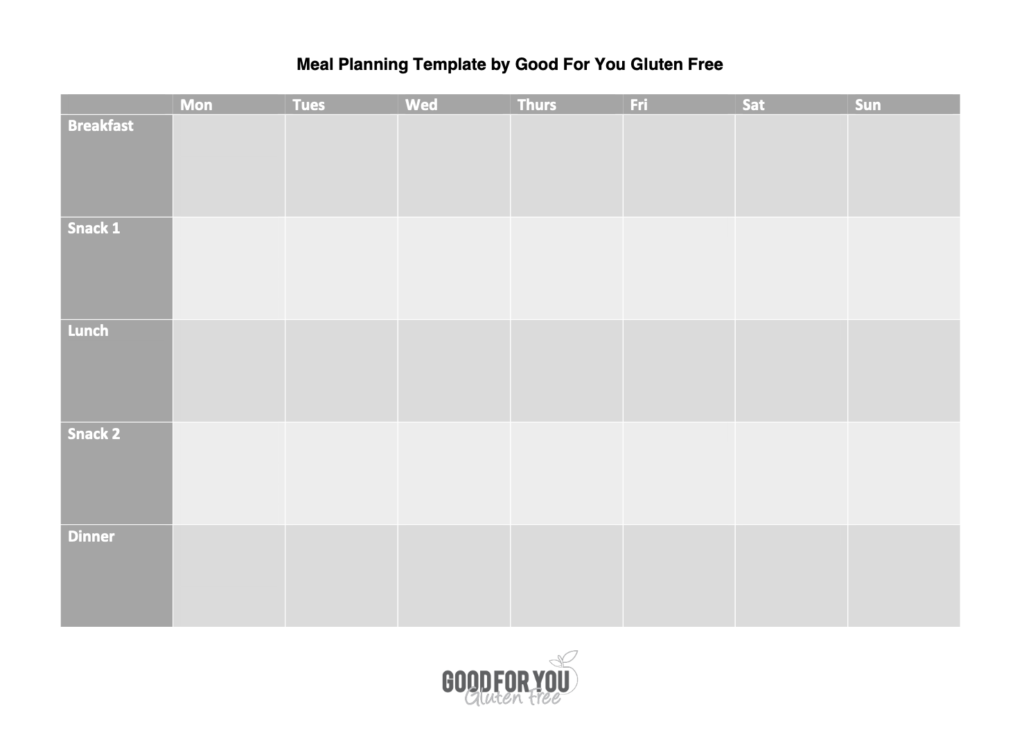
(5) Assess the Fridge and Pantry (and Garden!) for Meal Ideas
Check the fridge to see what items you already have on hand and need to cook up before they spoil. Use those ingredients in your meals so you save money and waste less.
If your garden is bursting with zucchinis, for example, make sure to whip up some meals to use those delicious gourds before they go bad.
Meals that require perishable foods (aka, foods that spoil quickly, like lettuce) are better made at the start of the week, and foods with a longer shelf life work better for meals at the end of the week.
(6) Start Slowly
If meal planning is intimidating to you, start by planning 1-2 meals per week, then build from there. Once you get more confident with your meal planning skills, add more meal ideas to your weekly plan.
Don’t let yourself get overwhelmed by trying to do too much. Go easy on yourself.
Over time, and as your recipe collection grows, you can start to get more creative and try new things. I tell all my clients to try a new recipe at least once every month, or better, every 1-2 weeks.
(7) Make Planned Leftovers
Make extra food to ensure you have plenty of planned leftovers on hand, especially when the food you’re making reheats well the next day or night.
I also like to make extra food so I can pack it in school lunches. My kids love taking leftovers for lunch, and they hate when I pack boring sandwiches.
I use warm/cold thermos for transporting warm leftovers in school lunches.
(8) Use Your Slow Cooker
The slow cooker can be an amazing tool to create a large pot of chili or soups that can be enjoyed all week long and even placed in a freezer-safe container for a rainy day.
(9) Create Freezer Meals
Freezer meals are wonderful in a pinch, and they’re easy to make.
An easy way to do this is to double your fish marinade one night, then pour it over a second portion of fish. Freeze the marinaded fish to cook up another night.
You can also portion leftovers into freezer-safe containers and create your own “TV dinner” meals to use in a pinch.
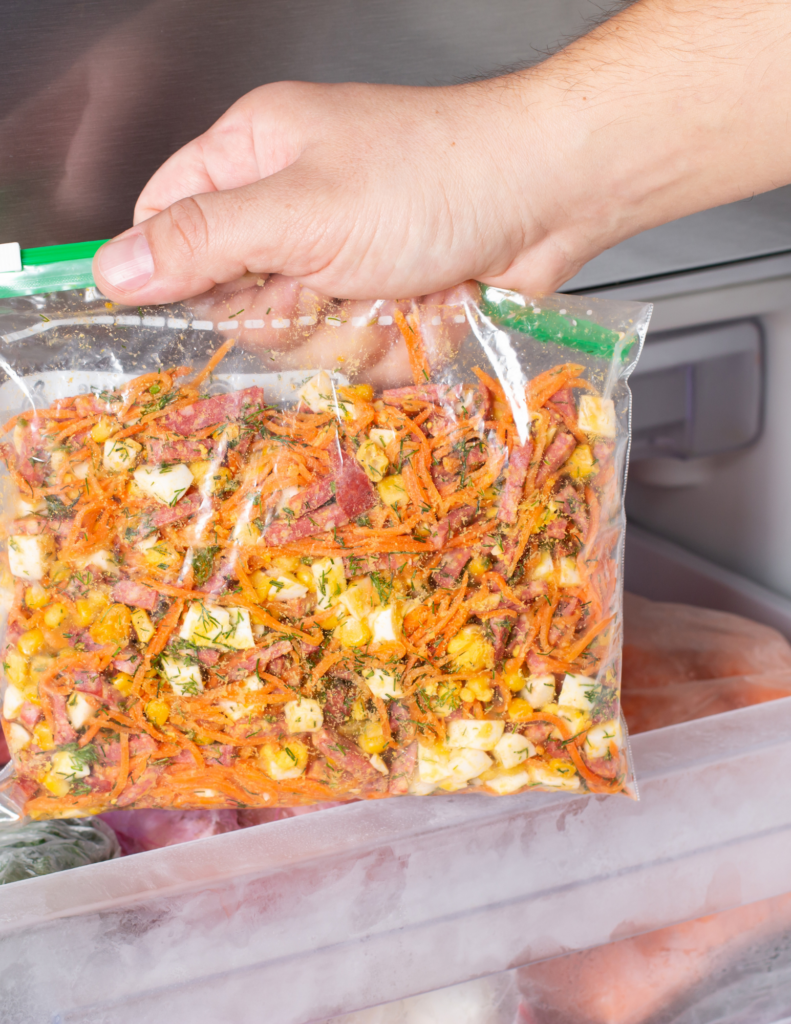
(10) Use One Ingredient in Multiple Ways
Repurposing ingredients is an excellent way to save money because you can buy ingredients in bulk and then use those ingredients for multiple meals.
For example, grilled or baked salmon leftovers can turn into salmon quinoa burgers the next night. Just be sure to make extra salmon and quinoa the first night so you have plenty to work with the next day.
I like to buy a huge bag of broccoli at Costco, but sometimes find it hard to use up before it spoils.
Meal planning encourages me to incorporate broccoli into several meals for the week – broccoli soup one night, then steamed broccoli a second night, and orange chicken with added broccoli the next.
Rotisserie chicken can also be used in many ways. I might enjoy it as-is on the first night, then add the bones to make a chicken dumpling soup the next night or use leftover chicken to make gluten-free chicken pot pie.
(11) Shop With a List
There’s nothing worse than realizing an important ingredient is missing in one of the meals you want to make.
Before grocery shopping, review the recipes you’re going to make for the week and write down all the ingredients you need. Sort your grocery list by section of the store (produce, dairy, pantry staples, etc.) for easy shopping.
Be sure to audit your pantry and fridge for ingredients you already have so you don’t overbuy and overspend.
(12) Add Variety in Cooking Styles
You may choose to grill one night, slow cook another night, and bake the following night.
You can also experiment with different cooking methods, such as roasting, grilling, and sautéing, to keep meals interesting and fun.
(13) Do the Prep Work
It might be helpful to prepare your food immediately after going to the grocery store. This can be a good time to chop and divide vegetables for the week, portion out meat and fish, and even get your marinades ready, especially in anticipation of a busy week.
(14) Invest in Meal Planning
Meal planning is an art, and it takes time to prepare a solid meal plan and shop for the right ingredients.
Don’t be afraid to invest time and money into getting meal planning right. Remember, your health depends on it.
If you need help getting started, I encourage you to download one of the following meal-planning PDFs:
(15) Be Flexible
Finally, don’t be afraid to switch things up if your plans change or you’re not in the mood for a particular meal. Meal planning should be flexible and adaptable to your needs. Just roll with the punches.
Creating the Perfect Gluten-Free Plate
To ensure you get good nutrition and plenty of variety, make sure each meal contains a mix of the following:
(1) Vegetables & Fruit: Vegetables and fruits are essential components of a balanced and healthy diet. These are packed with vitamins, minerals, and fiber that support good health and prevent chronic diseases.
To build a complete plate or meal, aim to fill half your plate with vegetables and fruit. Choose a variety of colors and types to ensure that you’re getting a range of nutrients.
(2) Protein: Protein is an important nutrient that helps build and repair tissues in the body. It’s also essential for maintaining a healthy immune system.
To build a complete plate or meal, aim to include a source of protein, such as lean meats, poultry, fish, eggs, tofu, or legumes. Protein should make up about a quarter of your plate or meal.
(3) Healthy Fats: Healthy fats are important for brain function, heart health, and hormone balance. They can also help keep you feeling full and satisfied after meals.
To build a complete plate or meal, aim to include a source of healthy fats, such as nuts, seeds, avocado, olive oil, or fatty fish.
(4) Complex Carbohydrates: Complex carbohydrates are important for providing energy and supporting brain function.
Unlike simple carbohydrates, which are found in sugary foods and drinks, complex carbohydrates are found in whole grains, beans, and starchy vegetables.
To build a complete plate or meal, aim to include a source of complex carbohydrates, such as brown rice, quinoa, sweet potatoes, or whole-grain gluten-free bread. Complex carbohydrates should make up about a quarter of your plate or meal.
The Bottom Line
Incorporating meal planning into your routine can be a game-changer for your health and well-being. With these 15 gluten-free meal planning tips, you’ll be well on your way to creating delicious, nutritious meals that are free from gluten and packed with flavor.
Be sure to stock your pantry with healthy staples, experiment with new recipes, and incorporate a variety of foods into your meals. This will ensure you’re enjoying a balanced and varied diet that meets all your nutritional needs.
Additional Reading
You might enjoy these articles, too:
- Supplements for Celiac Disease and Gluten Intolerance
- 200+ Foods You Can Eat on the Gluten-Free Diet
- 100+ Foods That Contain Gluten (or May Contain Gluten)
- What Gluten-Free Labeling Laws and Certifications Really Mean
- Gluten-Free Meal Kits by Green Chef
- Gluten-Free Lunchables
- 42 Gluten-Free Lunch Ideas For Kids and Adults
Need Help Figuring Out What to Eat? If you still need help figuring out what to eat now that you’re on a gluten-free diet, I encourage you to download my 45-Gluten-Free Recipe Pack. It’s well worth the investment to ensure you eat right!
I also encourage you to enroll in my SIGNATURE Gluten-Free Course to learn the ins and outs of a successful and healthy gluten-free lifestyle.
